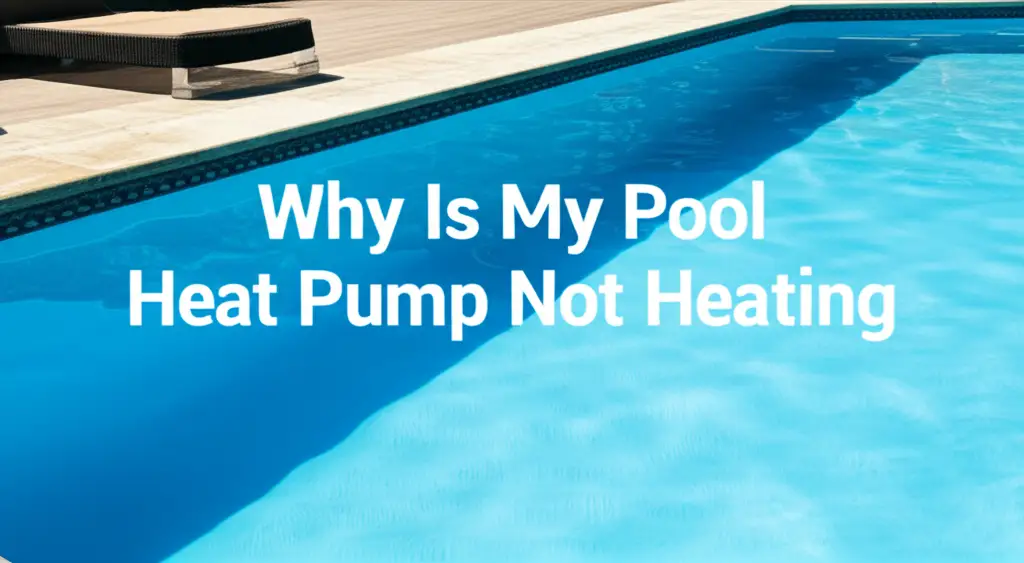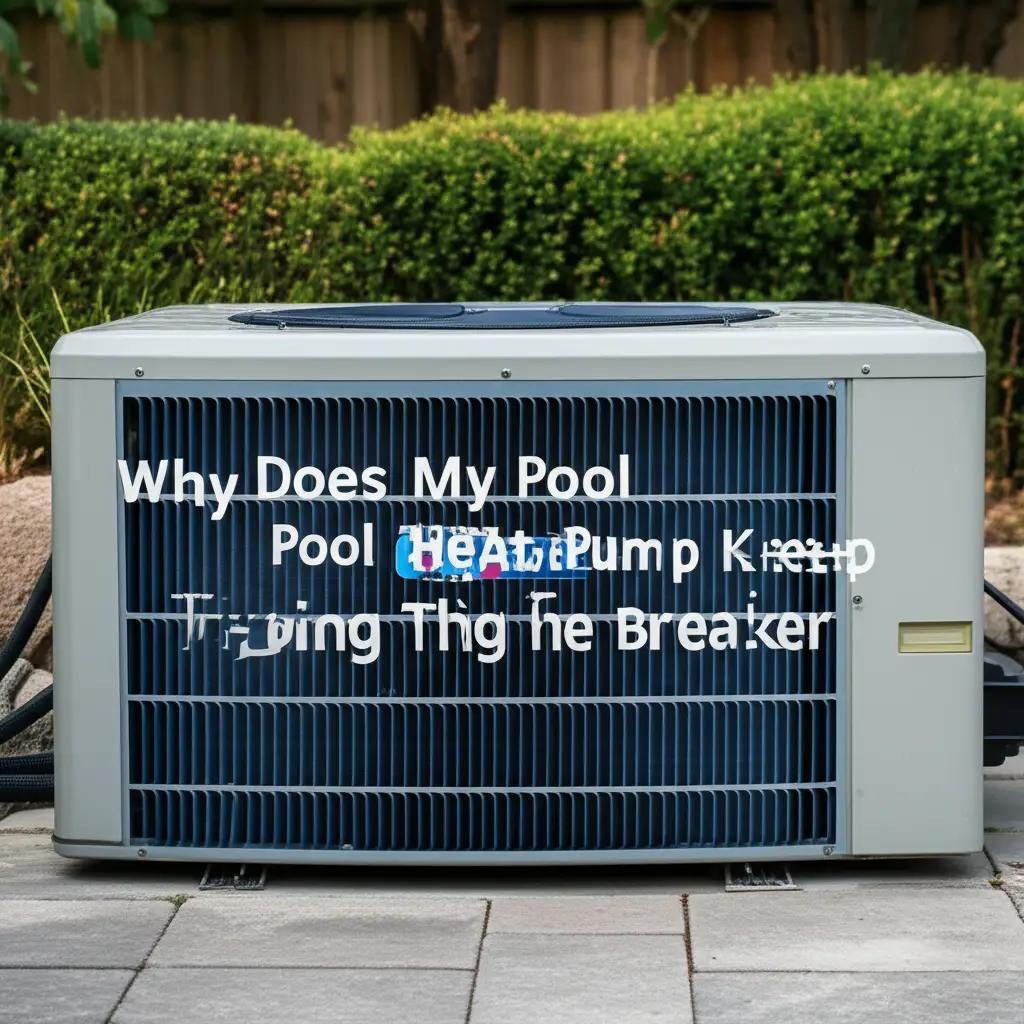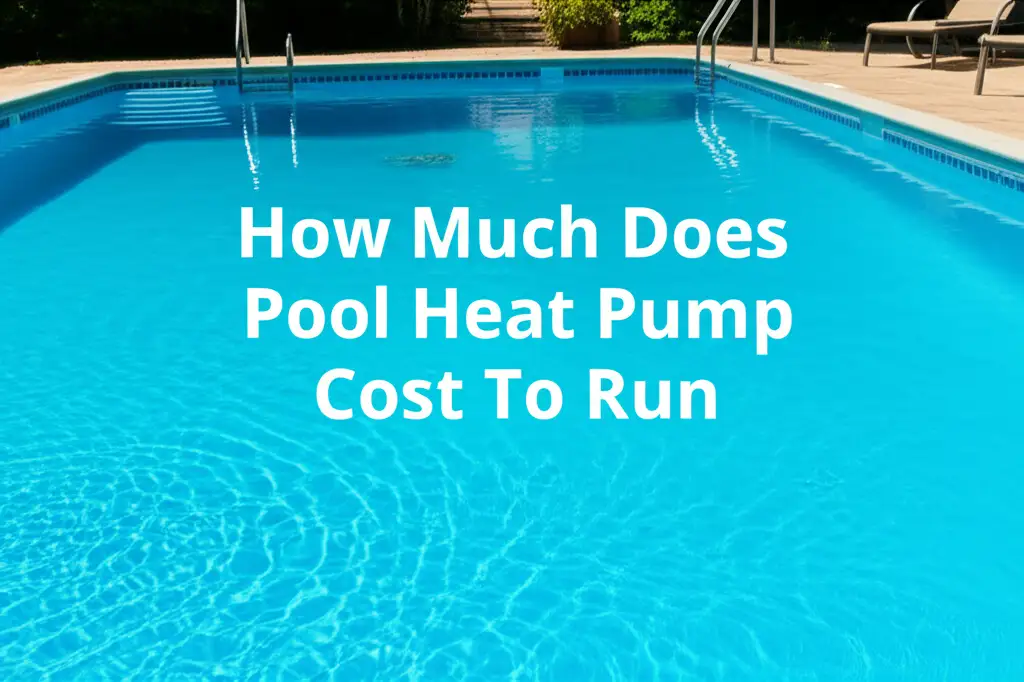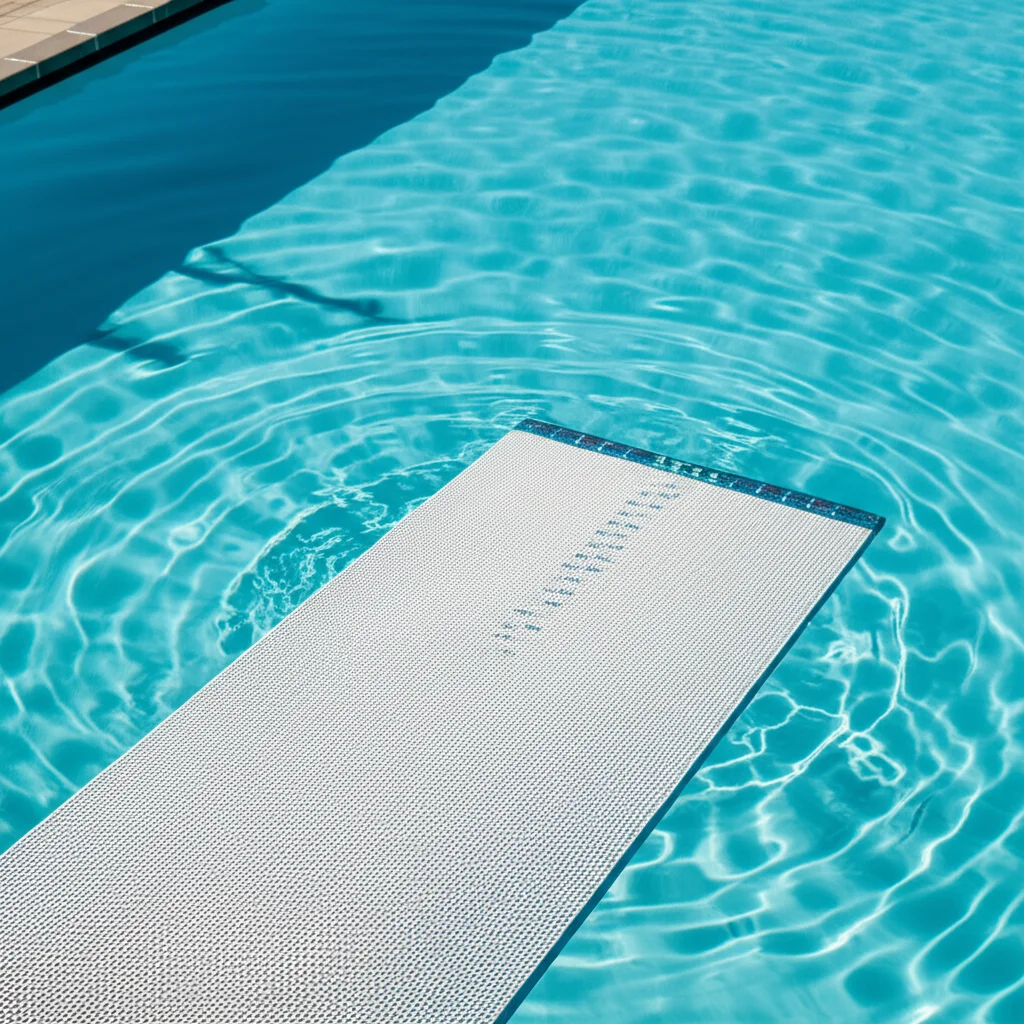· Katria Melrose · Pool Equipment & Troubleshooting · 16 min read
Why Is My Pool Heat Pump Not Heating

Troubleshooting Your Pool Heat Pump: Why It’s Not Heating
Imagine diving into your pool, expecting warm, inviting water, only to find it surprisingly cold. This can be very disappointing. If your pool heat pump not heating your water, you are not alone. This is a common problem many pool owners face. It can disrupt your swimming plans and make your pool unusable.
A pool heat pump works by taking heat from the air and transferring it to your pool water. When it stops working, figuring out the cause can be tricky. Many factors can stop a heat pump from warming your pool. These range from simple settings issues to more complex mechanical failures. I understand how frustrating this can be. This article will help you understand why your pool heat pump might not be heating. We will cover common reasons and provide actionable steps to troubleshoot them. By the end, you will have a clear path to get your pool back to the perfect temperature.
Takeaway
- Check Water Flow: Ensure adequate water flow through the heat pump. Low flow is a common culprit.
- Verify Settings: Confirm the thermostat is set correctly for your desired temperature.
- Inspect Electrical: Look for tripped breakers or power supply issues.
- Clean Components: Keep coils and filters clean for efficient operation.
- Listen and Observe: Pay attention to strange noises or error codes.
- Consider Professionals: Call an expert for complex electrical or refrigerant issues.
A pool heat pump not heating your water often points to issues with water flow, incorrect thermostat settings, electrical problems, or dirty coils. Addressing these common areas can help restore proper function.
Insufficient Water Flow: A Primary Obstacle to Pool Heating
Your pool heat pump needs a steady and strong flow of water to operate correctly. It transfers heat from the air to the water passing through its internal components. If the water flow is too low, the heat pump cannot efficiently exchange heat. Many heat pumps have a built-in safety switch. This switch will prevent the unit from running without enough water flow. It protects the system from damage. This is often indicated by a “no flow” error message on the control panel.
Several issues can lead to low water flow. A clogged pool filter is a very common cause. Debris builds up in the filter, restricting water movement. A dirty pump basket can also block water. The skimmer basket collects leaves and other large debris. If this basket fills up, it reduces water entering the pump. A closed or partially closed valve in your plumbing system can also limit flow. Sometimes, air can get trapped in the system. This is called an air lock and also prevents proper water circulation.
Diagnosing Water Flow Issues
First, check your pool pump. Make sure it is running. The heat pump will not operate without the main pool pump sending water through it. Next, inspect your skimmer and pump baskets. Empty any debris you find. Then, check your pool filter. If it is dirty, clean or backwash it according to your filter type. Look at all valves in your pool plumbing. Ensure they are fully open, allowing water to pass freely to and from the heat pump.
If your pool heat pump displays a “no flow” message, this is a clear sign. Addressing these flow issues is usually the first step in troubleshooting. You can find more information about this specific error here: Why Does My Pool Heat Pump Say No Flow. Ensuring proper water circulation is vital for any pool heating system. Without it, your pool heat pump cannot perform its primary function of heating your water.
Incorrect Thermostat Settings and Control Panel Problems
Even the most advanced pool heat pump cannot heat your pool if the settings are wrong. The thermostat is your command center for pool temperature. An incorrect setting is a common and simple reason your pool heat pump not heating as expected. Sometimes, the desired temperature is set too low. Other times, the heat pump might be in the wrong mode. For instance, some units have a “cool” mode or a “spa” mode. If it is in the wrong mode for pool heating, it will not work.
The control panel itself can also malfunction. Buttons might stick or not respond. The display might show garbled text or remain blank. A faulty control panel makes it impossible to correctly set the heat pump. It might also prevent the unit from receiving commands. This can leave your pool water cold even when everything else seems fine. Electrical surges or internal component failures can damage the control panel.
Checking and Adjusting Settings
Always start by checking your heat pump’s control panel. Verify the desired temperature setting. Make sure it is higher than your current pool water temperature. For example, if your pool is 70°F, set the heat pump to 80°F or higher. Confirm the heat pump is set to “heat” mode. If it has a “cool” or “off” mode, switch it to “heat.” Some units might have a timer or a lockout feature enabled. Check your owner’s manual to disable these features if they are active.
If the control panel is unresponsive or displaying errors, it might need attention. Sometimes, simply powering the unit off and on at the breaker can reset it. This can clear minor glitches. If the control panel remains unresponsive, it may be faulty. For detailed troubleshooting on panel issues, read this article: Why Is My Pool Heat Pump Control Panel Not Working. Fixing the control panel is crucial for proper operation.
Dirty Coils and Restricted Airflow
A pool heat pump works by extracting heat from the air. This process relies on unrestricted airflow over the evaporator coil. The evaporator coil is a large, finned coil where the refrigerant absorbs heat from the air. If this coil gets dirty, it significantly reduces the heat transfer efficiency. Dust, leaves, grass clippings, and other outdoor debris can accumulate on the coil fins. This layer of grime acts like an insulator. It prevents the coil from absorbing heat effectively from the air.
Restricted airflow also means the fan has to work harder. This can lead to increased energy consumption and premature wear on the fan motor. In severe cases, the heat pump may struggle to gather enough heat to warm the water. This results in little to no temperature increase in your pool. A dirty coil is a very common cause of a pool heat pump not heating as it should.
Cleaning Heat Pump Coils and Ensuring Airflow
Regular inspection and cleaning of the heat pump’s exterior and coils are essential. First, power off the heat pump at the breaker for safety. Use a soft brush or a garden hose to gently clean the outside of the coil. Be careful not to bend the delicate fins. You can spray water through the fins from the inside out to push debris away. Remove any leaves, twigs, or other obstructions around the unit. Ensure there is at least two feet of clear space around all sides of the heat pump. This allows for proper air intake and exhaust.
Inspect the fan blades for debris. Clean them if necessary. Regular cleaning of the heat pump coils helps maintain efficiency. It also extends the lifespan of your unit. This simple maintenance step can often restore heating performance. For a complete guide on how to clean these vital components, see this resource: How To Clean Heat Pump Coils. Keeping your coils clean is a key part of heat pump maintenance.
Refrigerant Leaks or Low Levels
Refrigerant is the lifeblood of your pool heat pump. It is the substance that absorbs heat from the air and releases it into the pool water. The heat pump works on a closed-loop system where refrigerant cycles through various components. A leak in this system can cause the refrigerant level to drop. When refrigerant levels are low, the heat pump cannot transfer heat efficiently. It will try to run, but the output will be cool or lukewarm air instead of warm air.
Signs of a refrigerant leak include a noticeable drop in heating performance. You might also hear unusual hissing noises near the unit. Sometimes, ice may form on the coil, even when the ambient air temperature is above freezing. This happens because low refrigerant pressure causes the coil to get excessively cold. A professional with specialized tools can detect refrigerant leaks.
Addressing Refrigerant Issues
Dealing with refrigerant is not a DIY task. Refrigerants are chemicals that require careful handling. They are under high pressure. Releasing them into the atmosphere is harmful to the environment. It is also illegal. If you suspect a refrigerant leak, you must contact a qualified HVAC technician. They have the training and equipment to safely locate the leak. They can repair it and properly recharge the system with the correct type and amount of refrigerant.
Do not attempt to add refrigerant yourself. Adding too much or the wrong type can cause serious damage to the compressor. It can also lead to more expensive repairs. A professional can diagnose the exact issue. They will ensure your heat pump operates safely and efficiently again. This ensures your pool heat pump not heating problem is resolved correctly.
Electrical Supply and Breaker Trips
A pool heat pump is a powerful electrical appliance. It requires a stable and sufficient power supply to operate. Electrical issues are a common reason why a heat pump stops heating. The most straightforward electrical problem is a tripped circuit breaker. A circuit breaker protects your home’s wiring from overcurrents. If the heat pump draws too much power, or if there is a short circuit, the breaker will trip. This cuts off power to the unit.
Other electrical issues can include loose wiring connections. Over time, connections can become loose, leading to intermittent power or no power at all. Faulty capacitors or contactors are also common problems. Capacitors help start the compressor and fan motor. Contactors are switches that control power flow. If these components fail, the heat pump will not run or will not run correctly. This results in no heat production.
Checking Electrical Components Safely
First, always prioritize safety when dealing with electricity. Turn off the main power to the heat pump at the circuit breaker before any inspection. Locate your home’s electrical panel. Look for the breaker labeled for your pool heat pump. If it is in the “off” or “tripped” position (usually midway between “on” and “off”), flip it completely to “off” and then back to “on.” If the breaker trips again immediately or soon after, there is a serious electrical problem. This often indicates a short circuit or an overloaded component.
If the breaker stays on, check all visible wiring connections at the heat pump. Ensure they are secure. You might need a multimeter to test for voltage at various points. However, if you are not comfortable with electrical work, it is best to call a licensed electrician or a pool heat pump technician. They can safely diagnose and repair complex electrical issues. For more details on why breakers trip, you can refer to: Why Does My Pool Heat Pump Keep Tripping The Breaker. Addressing electrical problems ensures your heat pump gets the power it needs.
Compressor or Fan Motor Malfunctions
The compressor and the fan motor are critical components of a pool heat pump. The compressor is the heart of the refrigeration cycle. It compresses the refrigerant gas, increasing its temperature and pressure. This is where the heat really gets concentrated. If the compressor fails, the heat pump cannot move heat from the air to the water. This means your pool will remain cold. A failing compressor might make strange noises, such as grinding or loud humming. It might also struggle to start.
The fan motor circulates air over the evaporator coil. It pulls in warm ambient air. If the fan motor fails, airflow stops. Without proper airflow, the heat pump cannot absorb heat from the air. Even if the compressor is working, no heat transfer occurs. This leaves your pool water at its current temperature. You might notice the fan not spinning, or it might make loud squealing noises.
Identifying Component Failures
To check the fan, first ensure the power is off at the breaker. Look into the top of the heat pump. See if the fan blades are obstructed. Remove any debris. Gently try to spin the fan blades by hand. If they do not spin freely, the motor bearings might be seized. If the fan runs but provides very little airflow, the blades might be damaged or loose.
Diagnosing a compressor failure is more complex. You might hear a clicking sound as the unit tries to start but fails. The unit may hum loudly but not produce heat. These symptoms often indicate a capacitor issue or an internal compressor fault. Compressor and fan motor replacements are highly specialized repairs. They involve working with refrigerants and high voltage electricity. These tasks require professional knowledge and tools. If you suspect either of these components is faulty, it is essential to call a qualified pool heat pump technician. They can accurately diagnose the problem and perform the necessary repairs safely.
Environmental Factors and Cold Weather Limitations
Pool heat pumps are highly efficient, but their performance depends heavily on the ambient air temperature. Unlike gas heaters that generate heat, heat pumps extract existing heat from the air. This means they are most efficient in warmer climates or during warmer seasons. Most pool heat pumps require an air temperature of at least 45-50°F (7-10°C) to operate effectively. Below this temperature, their heating capacity significantly drops. Some advanced models can work at lower temperatures, but their efficiency will still be reduced.
If your pool heat pump not heating your water, and it’s a cold day or late in the season, the low ambient temperature is likely the culprit. The heat pump simply cannot extract enough heat from the cold air to transfer to your pool. This is a common misunderstanding. People expect the same performance regardless of outdoor conditions. Cold weather can also lead to issues like freezing on the evaporator coil. When the coil gets too cold, moisture in the air can freeze on its surface. This further impedes heat transfer.
Understanding Heat Pump Performance in Cold
Check the outdoor air temperature. Compare it to the minimum operating temperature specified in your heat pump’s manual. If the temperature is too low, the heat pump will not heat effectively, or it may not run at all. Some heat pumps have a defrost cycle. This cycle temporarily reverses the refrigerant flow to melt ice off the coil. If this cycle fails, or if the temperature is consistently too low, ice can build up.
In colder conditions, you might need to use a pool cover to retain heat. A solar cover is excellent for preventing heat loss. It can also add some solar gain during the day. If you live in an area with consistently low temperatures, a heat pump might not be the sole heating solution for year-round swimming. You might need a supplementary heater, like a gas heater, for colder months. Understanding these environmental limitations helps manage expectations. It also ensures you use your heat pump under optimal conditions. Learn more about preventing freezing issues here: How To Keep Your Heat Pump From Freezing Up.
FAQ Section
How do I know if my pool heat pump is working?
You can check if your pool heat pump is working by listening for the compressor and fan. The fan should be blowing air, and the compressor should be humming. Place your hand near the air discharge. The air coming out should feel cooler than the ambient air. The pool water temperature should slowly increase over time. For more specific checks, refer to your heat pump’s display for error codes or operational indicators.
What temperature should I set my pool heat pump to?
The ideal temperature for most residential pools is between 78°F and 82°F (25.5°C to 27.8°C). Setting it higher can increase running costs. Setting it too low might not be comfortable for swimming. Adjust the thermostat on your heat pump’s control panel to your desired temperature. Make sure it is higher than the current water temperature to activate heating.
How long does it take for a pool heat pump to heat water?
The time it takes depends on several factors. These include the pool size, the heat pump’s BTU rating, and the initial water temperature. It also depends on the ambient air temperature. Typically, a pool heat pump can raise the water temperature by 1-2 degrees Fahrenheit per day. Larger temperature increases or larger pools will take longer. Using a pool cover significantly speeds up the heating process and reduces heat loss.
Can a pool heat pump work in cold weather?
Most standard pool heat pumps are designed to work efficiently in ambient air temperatures above 45-50°F (7-10°C). Below this threshold, their heating capacity decreases significantly, and they may struggle to heat the pool or shut down. Some newer models offer low-ambient temperature operation, but even these will be less efficient in very cold conditions.
When should I call a professional for my pool heat pump?
You should call a professional if you suspect a refrigerant leak, experience persistent electrical issues, or hear unusual noises from the compressor or fan motor. If basic troubleshooting steps like cleaning coils, checking water flow, or adjusting settings do not resolve the problem, it is time for expert help. Professionals have specialized tools for diagnosis and repair.
Conclusion
When your pool heat pump not heating the water, it can quickly turn your refreshing oasis into a chilly disappointment. We have explored the most common reasons behind this problem. These range from simple issues like low water flow or incorrect thermostat settings to more complex mechanical or electrical failures. Remember, often, a little investigative work can uncover the cause. Checking your water flow, cleaning dirty coils, and ensuring correct settings are great starting points.
While many problems can be addressed with basic DIY troubleshooting, some issues demand professional expertise. Refrigerant leaks, persistent electrical faults, or major component failures like the compressor or fan motor are best left to qualified technicians. Prioritizing regular maintenance is crucial. This proactive approach helps prevent many common heat pump problems. It ensures your unit runs efficiently and reliably for years to come. Do not let a cold pool ruin your summer. With these insights, you can often diagnose and resolve the issue. If not, you will know when to seek professional help. Enjoy your warm, inviting pool once again!
- pool heat pump
- pool heating issues
- heat pump repair
- pool maintenance
- troubleshooting heat pump
- no heat pool
- pool equipment





